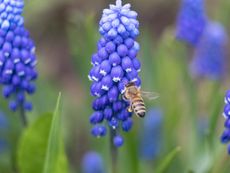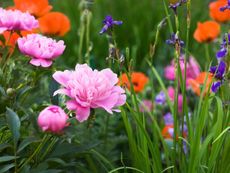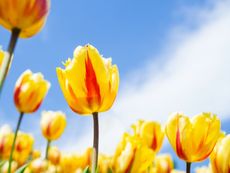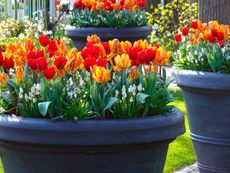Dormant Bulb Watering – Do I Water Bulbs After Flowers Are Gone


Spring displays of bulbs are one of the earliest signs of the growing season and a pleasure to view. Once the petals have all fallen off the plants, should you water the dormant bulbs? Bulbs should stay in the ground for as long as there is foliage so the plant can gather solar energy for the next season's growth. Summer care of spring bulbs means retaining foliage for as long as possible. How much maintenance do you need to do? Read on for the answer.
Should You Water Dormant Bulbs?
Many gardeners neglect spent bulb plants or even cut off their foliage. This is a no-no, as plants need leaves to gather energy through photosynthesis. This is actually a very important part of the bulb life cycle. If plants cannot gather energy and store it in the bulb, the following season's blooms and foliage will be negatively affected. While plants retain foliage and are doing their work, the entire plant will need to be maintained. Watering bulbs after flowering is important to support root systems and keep leaves in good condition. Think of it this way. You wouldn't stop watering your rhododendron after it had flowered, would you? It may not need as much water to support blooms, but it still needs to have water to the root system that will keep leaves fresh and hydrated and transport nutrients to all the parts of the plant. To suspend watering would mean the plant would eventually wither and die. Dormant bulb watering is a necessary part of after bloom care and can help the plant save up energy for the next year. The xylem in plants is the vascular system that directs water into the cells and all parts of the plants. It is directly connected to the roots and water flows upward to hydrate and bring nutrients to fuel cell growth. Without water, the plant's vascular system cannot do this important work.
About Dormant Bulb Watering
We have established that watering bulbs after flowering is a necessary chore, but how much and how frequently? This will depend on the site and the type of flowering bulb. In dry, well-draining soil, the water will redirect quickly, and plants will need to be watered more frequently, preferably when the top couple of inches (5 cm.) of soil is dry to the touch. In areas that do not drain as freely, the same touch test can be used, but the amount of water will be significantly reduced to prevent the bulb from drowning. In container grown plants, watering bulbs after flowers are gone will be a more frequent chore. This is because the container tends to dry out more quickly due to wind and ambient conditions than in ground bulbs.
General Summer Care of Spring Bulbs
As long as soil is kept moderately moist and the foliage appears healthy, some other care should be observed. Remove spent flower stems, as they force the plant to direct energy to maintaining them when you really want all the energy to go into the bulb. Do not tie up the foliage as some gardener's urge. This reduces the leaf space that can gather solar energy to turn into stored plant sugars. Allow foliage to remain on the plant for eight weeks. Remove the foliage when it has turned yellowish brown. If the bulbs have been in the ground for several years, use a garden fork to lift them. Discard any discolored or diseased bulbs and replant clusters of two to three in separate areas. This will promote the formation of more bulbs and a healthier group of plants.
Gardening tips, videos, info and more delivered right to your inbox!
Sign up for the Gardening Know How newsletter today and receive a free download of our most popular eBook "How to Grow Delicious Tomatoes."

Bonnie Grant is a professional landscaper with a Certification in Urban Gardening. She has been gardening and writing for 15 years. A former professional chef, she has a passion for edible landscaping.
-
 Clever Vertical Vegetable Garden Ideas For Small Spaces – 7 Ways To Save Space
Clever Vertical Vegetable Garden Ideas For Small Spaces – 7 Ways To Save SpaceShort on garden space? Learn some vegetable garden ideas for small spaces that are fun and easy.
By Mary Ellen Ellis
-
 26 Different Types Of Orchids – With Pictures & Information
26 Different Types Of Orchids – With Pictures & InformationDiscover stunning orchid types to grow in your home and garden – from easy beginner varieties to rare and exotic species that are the preserve of experts.
By Melanie Griffiths
-
 Pretty Spring Bulbs For Pollinators
Pretty Spring Bulbs For PollinatorsWhat are the best flowering bulbs for pollinators in spring? Click here to find out.
By Mary Ellen Ellis
-
 Grow An Early Spring Flowering Bulb Lawn
Grow An Early Spring Flowering Bulb LawnWant a lawn that nourishes pollinators, never needs weeding, and grows more beautiful every year? We have the lawn for you. Click for more.
By Caroline Bloomfield
-
 When To Dig Up Bulbs That Bloom In Summer
When To Dig Up Bulbs That Bloom In SummerClick here to learn when to dig up faded summer bulbs of some of the most common ornamentals grown.
By Tonya Barnett
-
 Corms, Tubers, And Bulbs That Are Deer Resistant
Corms, Tubers, And Bulbs That Are Deer ResistantWe love tulips, and so do deer! If you have hungry deer and you hunger for spring blooms, this article should help.
By Amy Grant
-
 Care for Bulbs After Blooming
Care for Bulbs After BloomingIt's tempting to chop down the leaves after you bulbs have bloomed, but you have to resist this urge! Click to learn why.
By Amy Draiss
-
 Best Spring Bulbs for Sun and Shade: Bulbs That Grow in Shade and Full Sun
Best Spring Bulbs for Sun and Shade: Bulbs That Grow in Shade and Full SunBulbs are beautiful harbingers of spring. Most flower bulbs thrive in full sun, but what if you have a shaded landscape? Read on for more.
By Amy Grant
-
 Bulb Life Cycle In Winter: What Bulbs Do For Months Under The Snow
Bulb Life Cycle In Winter: What Bulbs Do For Months Under The SnowDormancy in winter doesn't mean nothing is happening with bulbs. It just means you don't see any growth above the ground. Read on for more.
By Bonnie L. Grant
-
 How To Plant Bulbs In Pots - Lasagna Style
How To Plant Bulbs In Pots - Lasagna StylePlanting bulbs in containers is an easy way to create a gorgeous spring porch arrangement, especially when you use the lasagna method.
By Laura Walters